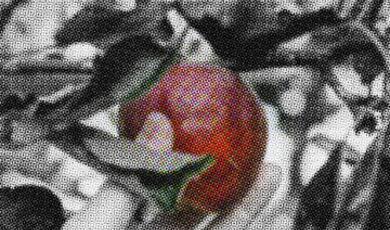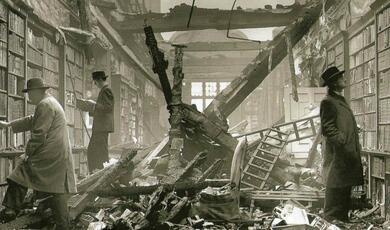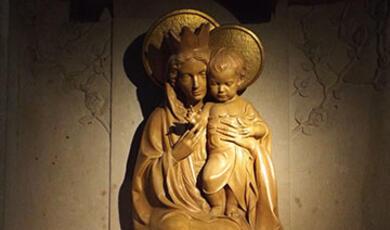30 March 2012
Modern Art:
The Art of Modern Life?
Professor George Pattison
Modern art—but what is ‘modern art’? Whatever it is, one thing is sure—that its history has been marked by a succession of attempts to define it. Since these attempts have often been proposed in such a way as to promote one kind of art or to exclude some other from the canon of ‘modern art’, they have mostly been violently contested and none has taken entire possession of the field. Indeed, defining the field—is it art?—is part of what is at issue in such debates!
I shall not now go any further into such controversies, but shall rather attempt to illustrate one particular view of modern art—an exceptionally influential one, as it happens—by referring to a range of artists and their works that might reasonably be classified as ‘modern’ and to reflect on how this might help us to think theologically about modern art. The view in question is that suggested by Baudelaire in his essay ‘The Painter of Modern Life’, a eulogy of Constantin Guys. Baudelaire does not claim Guys for modern art on the basis of some formal principle, but simply on the basis of is being a ‘painter of modern,’ i.e., contemporary ‘life’.Whilst the public at large are inclined to think of ‘art’ as more or less identical with the great works of the Titians and Raphaels collected in the Louvre, or perhaps even what Baudelaire calls ‘the charming and coloured engravings of the last century’, ‘these artists portray the past; now it is to the painting of contemporary manners that I wish to pay particular attention today’. The past, as he goes on to say, is interesting by virtue of its being the past but, he continues, ‘The same thing is true of the present. The pleasure we derive from the portrayal of the present comes not only from the beauty in which it may be clothed but also from its essential quality of being present.[1] This, then, is Guys’ service to art: that he is an unashamed painter of the present, an artist enraptured by the life of the modern urban crowd, and, like Edgar Allan Poe’s ‘man of the crowd’ ‘joyfully breathes in all the germs and emanations of life’ under the spell of a ‘fatal, irresistible’ curiosity.[2] In an authoritative and influential study, T. J. Clark transposed Baudelaire’s phrase to ‘Manet and his followers’, making it a definitive feature of the break-through to modernity that occurred in mid-nineteenth century Paris. And, of course, Manet and subsequent impressionists were also very much ‘painters of modern life’, like Guys painting the sights and evoking the sounds of modern life, from pleasure parks,to railways, to horse-racingand on to war, insurrection, and execution.
In this perspective, ‘modern art’ is simply doing today what art has always done. As Baudelaire says, ‘every painter of the past had his own modernity’, a point he illustrates by reference to how portraiture is always of its age, even down to ‘the gesture, the glance and the smile’ that is unique to each period. ‘Modernity’ is in this sense a trans-historical constant, albeit of a paradoxical kind. It is, as Baudelaire writes, ‘the transitory, the fugitive, the contingent, the half of art, of which the other half is the eternal and the immutable’.[3] Yet we may take issue with Baudelaire at this point and suggest that what we are accustomed to call modernity actually relates these two elements of art, the transient and the eternal, in a way that is very different from the art of previous ages. What is distinctively and characteristically ‘modern’ in this regard is precisely the exclusive attention to and absorption in ‘the present’, in what is transitory, fugitive, and contingent. And this is why Manet and the impressionists remain quintessentially ‘modern’and the Pre-Raphaelites do not—even though one may argue that there are aspects of their draughtsmanship, use of technical resources, and composition that are distinctively of the nineteenth century.
By using portraiture to make his point, Baudelaire was, of course, cutting a few corners, since this is the main genre in which the artistic concern to represent the present in its, as it were, present-ness reaches back into the medieval world. Yet, since classical times and until the last several centuries, the present-ness of the present has been only incidental to artistic representation. Religious artists of the later Middle Ages could incorporate touching scenes of contemporary rural life into Nativity scenes, for example, and by the time of Breughel these could be rendered almost as if they were present events.Bruegel also takes an interest in contemporary life for its own sake to a new level —even in pictures as metaphysically charged as ‘Hunters in the Snow’. As Hegel already commented, seventeenth Dutch painting of everyday life marked a new threshold in art’s ‘Protestant’ liberation from the hieratic and the classical and perhaps, in Baudelairean terms, this is the first truly ‘modern’ art, art that is content to be in and of its time.
Seeing modern art as the art of modern life may be too all-inclusive for the purposes of art critics, with their invariably polemical agendas. But it does give us a thread to follow links through many of the most diverse forms of ‘modern art’. The theologian Paul Tillich, like many of his German contemporaries, disparaged impressionism for its typically French fascination for the glittering surface of metropolitan lifeunlike the German expressionists, who looked beneath the surface to the dark, ambiguous depths beneath. But whatever their differences, both are painting ‘modern life’. Yet ‘Modern art’ is not what one would see in a photo album in which were collected all possible images of ‘modern life’ between 1862 and 2012 (for example), but the representation of all there is to see in such images, including what lies beneath the skin and what can only reveal itself from angles and points of view that are inaccessible to straightforward mimetic reproduction and thatmirror the new complexity—one is tempted to say ‘hyper-complexity’—of modern urban life in which the self is continuously barraged by reflected images of itself and others in shop-windows, photography, and the ubiquity of advertising and ‘art’ itself.In suchways the modern world inaugurates what has been called ‘a new kind of observer’. Nor is ‘modern life’ limited to the superficial kaleidoscope of colour, line, and incident that Baudelaire saw in the life of the contemporary crowd. As pioneered in the Crimean and American Civil Wars, photography, film, and painting would make images of war as essentially defining of the self-understanding of modernity as image of Parisian boulevards and parks. And, of course, war’s aftermath, in revolution, grief, and the maimed bodies of veterans, revelatory also of the unhealed scars inflicted on Europe’s soul.The Second World War would bring its own images of modern life, whether heroic, unendurable, or surpassing human understanding. Returning to the city, the twentieth century saw urban styles very different from those engaged by Baudelaire, Guys, and Manet—or, for that matter, Kirchner and the German expressionists. Edward Hopper is, supremely, the painter-poet of post-War urban anomie.And, just for a change, consider the contemporary British artist Rose Wylie, whose work is also, in its unique way, the painting of modern— in this case— British, everyday life.
At this point, however, you might want to object that I am, after all, making ‘modern art’ sound too much like a simple visual chronicle of modern times. Surely what is most characteristic of much ‘modern art’—and precisely why it so often provokes such violent reaction—is that it doesn’t look much like what the viewer supposes it’s ‘meant’ to represent. Or perhaps it doesn’t really look ‘like’ anything at allor isn’t intended to.For some critics, at least, the complete annihilation of external content was the ultimate goal of a truly modern art, the reduction of painting to the two-dimensional picture surface, pure painting, liberated—at last—from the tyranny of representation. Surely this isn’t ‘the painting of modern life’? A similar question might be raised by currents in so-called post modern or conceptual art.Even if the individual pieces of Damien Hirst’s ‘Last Supper’ are, in some sense, representations of the labels on pharmaceutical products, it is hard to say just what , if anything, this is meant to be a picture ‘of’. Sculptural works such as those of Anish Kapoor are so far from seeking to represent anything that they seem primarily to be aimed at combining a sheer delight in the technical possibilities of the materials with a whimsical transformation of our own self-experience.
The catalogue could be extended indefinitely, but, I suggest, even here there is a sense in which we are dealing with an ‘art of modern life’. For what these works ‘illustrate’, in a very loose sense of the word are distinctive features of modern life, features that we might sum up as the quest for autonomy, conceptualisation, and the reconfiguration of experience through technology. None of these are uncontested sites of the modern world—nothing in modernity is uncontested—but they are nevertheless strong themes running through modern life in various of its dimensions: intellectual, moral, political, and religious. The titles of Mondrian’s severely geometrical abstractions already alert us to what we might call the homeomorphism, the similarity of form, between such painting and the urban landscapes of New York and all the 20th and 21st century cities built ever more vertiginously in the image of Manhattan’s skyscraper skyline. Perhaps it is no coincidence that it was precisely in North America that abstract expressionism was to find its most fertile environment. In such works, whether we assign them to modern or postmodern art, we are called to witness the renunciation of the eternal and immutable.
If this is so, then we can perhaps begin to see why modern art has been so problematic for Christianity and why it has had considerable theological invective—sometimes officially sanctioned—heaped upon it. In general terms, this may simply be because a great many religious believers don’t get on well with modern life. Certainly, the culture of autonomy, of abstraction and conceptualisation, and of technocratic production has proved a culture that is at many points in tension or at odds with the cultural values of ecclesiastical Christianity. Nor is the potential conflict mitigated by the fact that many artists have nevertheless individually affirmed their commitment to spiritual values, thus Cezanne, or deployed Christian theological resources in their painting of modern life, thus Stanley Spencer. The challenge is especially clear with regard to the principle of autonomy.
Autonomy is one of the salient features of modern thought, adduced by Kant as a defining principle of the Enlightenment. In his essay ‘What is Enlightenment?’ the German philosopher famously wrote that Enlightenment is man's emergence from his self-imposed immaturity. Immaturity is the inability to use one's understanding without guidance from another. This immaturity is self-imposed when its cause lies not in lack of understanding, but in lack of resolve and courage to use it without guidance from another. Sapere Aude! [dare to know] "Have courage to use your own understanding!"--that is the motto of enlightenment ... Nothing is required for this enlightenment, however, except freedom...[4]
As a philosopher, Kant was especially concerned with the free use of reason in the pursuit of knowledge, but, as his essay goes on to make clear, this has important implications when it comes to matters of social order and the powers of temporal and spiritual powers to prescribe the limits within which freedom is allowed to operate. Yet Kant was undoubtedly aware that we are not our own makers and that there are limits—albeit not yet fully known—to what we can do and know, strictly on the basis of our own reasoning powers. Such reserve would not be acknowledged by many later thinkers, and, via Dostoevsky’s nihilists, the end of the nineteenth century would see programmatic declarations of the omnipotence of human beings to create their own values and realities. Nietzsche was, of course, the intellectual spokesman of such self-creating super-men, but his vision of the absolutisation of will-to-power as the foundation of human being was eagerly taken up by a generation of radical artists, including expressionists and futurists, and there was undoubtedly a dash of Nietzscheanism in aspects of the Bolshevik Revolution, even if the Bolsheviks necessarily spurned Nietzsche’s artistic individualism. This self-portrait by Otto Dix, representing himself as Mars in the helmet of the German Imperial Army quintessentially captures this particular early 20th century brand of Nietzscheanism.
We have gone rapidly, too rapidly, to extremes, and modern life testifies to manifold versions of autonomy that affect the way we are now at many levels. Think, for example, of the aspirations of nation states to independence from foreign rule, or the struggle to maintain national or regional languages or cultural traditions. Or think of the modern world’s pragmatism, its focus on ‘the job in hand’, suspending moral or other factors deemed extraneous to ‘the job’. This, then, is the context in which abstract art’s pursuit of the pure abstract form is itself so far from being abstracted from the general current of modern life as to represent one of its defining features—doing so, of course, in a form proper to visual art.
Yet autonomy is also a site of intense contestation, and not least in relation to theology and art. At the very beginnings of modern theology (often associated with the German theologian Friedrich Schleiermacher, who flourished in the first three decades of the nineteenth century), the view that human beings could attain to complete, autonomous self-mastery was opposed by the theological view that we cannot make any sense at all of human life unless we understand it as infinitely and absolutely dependent on God. A similar message would be propounded by Kierkegaard. And if Dostoevsky put in the mouth of the nihilist Kirillov the view that man had to assert his self-will to free himself from God, he did so only to show the emptiness, despair, and, ultimately self-destructive nature of the would-be superman. In the word of another Dostoievskian character, such radical autonomy is the modern world’s ‘rebellion’. In relation to art, Jacques Maritain would eloquently condemn the renaissance for surrendering the ‘blessed humility’ and communal values of the ‘matchless epoch’ of the Middle Ages for an individualism that would ultimately ‘prevent man from remembering God’.
We can therefore see that modern art, precisely by being the art of a culture striving for maximal autonomy, might challenge a religious view of life, and do so in such a way that our response to it calls in question how we are to understand our own way of being religious. Against the Nietzschean heroism of the generation of 1914, a Catholic artists such as Rouault would set the suffering Christ of his own Catholic devotion. A later self-portrait by Dix, from the end of the Second World War, also illustrates from another angle the failure of the more absolutist versions of autonomy. (Unfortunately I couldn’t trace this portrait, entitled Ecce Homo II on the internet, which is interesting in itself; this figure Ecce Homo is from a 1960 Stations of the Cross.)
Further to its pursuit of autonomy, the modern world is also marked by a hitherto unequalled tendency to conceptualisation, most obvious in the achievements of modern science. But conceptualisation and theory, necessary as they are for the practice of science, have also been extended beyond what might seem like their proper domains. This becomes especially problematic when it is the human being him- or herself who is seen reductively in the mirror of such conceptualisation. Not least controversially, Marxism in particular (though not uniquely) has, following Hegel in believing it to be possible to theorise the history of human freedom in such a way as to develop a ‘scientific’ view of history. This need not rule out all possible input from that mysterious element called human freedom, yet it would seem to project in advance the sphere within which freedom can be operative. Hegel regarded ‘freedom’ and ‘concept’ as effectively synonymous, but few since have shared his confidence that ‘the concept’ adequately expresses all of that to which human freedom aspires. Contemporary Darwinism and socio-biology, however, seem to be doing their best to revive the Hegelian paradigm!
Again it is unsurprising that this is a highly contested aspect of the culture of modernity. And, again, we might look to Dostoevsky, who saw in Peter the Great’s artificially created city of St Petersburg the world’s most theoretical city and, as such, the enactment of an ideological programme that sought to recreate a nation according to a certain concept of what a modern nation ought to be. And, for Dostoevsky, this was also to create the context in which the kind of forgetfulness of God typical of those who sought only their own radical autonomy could especially flourish. Since then, of course, many other nations, cities, and neighbourhoods have been created, sometimes more, sometimes less successfully as ‘projects’ in the cause of some form of civic or social engineering. But, even if successful, how well do such projects serve the interests of corporeal, incarnate human beings?
The question is raised in several poems by the Orcadian poet Edwin Muir. Muir sees Calvinism’s reduction of religious life to theology as anticipating a crisis endemic to modern European humanity: ‘The fleshless word, growing, will bring us down’, warns Muir in ‘The Incarnate One’, predicting the advent of an ‘Abstract calamity, save for those who can / Build their cold empire on the abstract man’.
For Muir, Dostoevsky, and other critics of modernity—but also, equally if oppositely, for modernity’s own advocates—the conceptualisation of life is not just about theory, in the sense of ‘pure theory’. It is also, critically, a means to the transformation and reconstruction of human experience itself. Lenin’s dictum that communism is ‘electrification + the soviets’ sums up much more than his own political programme. Pure science is only rarely pure, as the culture of research-funding makes clear. This is not to say that it is not virtuous, simply that its military, pharmaceutical, or psychological applications are only ever provisionally out of the picture, suspended but never absent.
So, too, modern art is, in many of its works, not about representing the experience of others but engendering new possibilities of experience for the viewer, indeed, shaking the viewer out of a purely contemplative pose into one of active engagement. Walter Benjamin famously spoke of how modern art has lost the aura of uniqueness in this age of mechanical reproduction. Why go to Paris to see such and such a work by Manet, when I can buy a good quality reproduction? Yet we do continue to go to Paris, or we flood to the blockbuster exhibitions that bring Paris (or Milan or Moscow) to us. We want to see it for ourselves, to taste it ‘with the tongue of the eye’, as Robert Natkin used to say, to have the experience. Seeing itself becomes experience. Art is a technically smart means of making us see things we wouldn’t otherwise see—as true of a painting by Monet as of an installation by Olafur Eliasson.
Whether the focus is on theory or experience, we cannot escape Baudelaire’s observation that what we are dealing with here is a matter of ‘the transitory, the fugitive, the contingent’ and not ‘the eternal and the immutable’. Edwin Muir’s first book, a collection of prose essays, was, in an allusion to Nietzsche, entitled ‘We moderns’, and the arguments between autonomy and heteronomy, between conceptualisation and experience are arguments about how ‘we’, ‘we moderns’, are to live our lives. They are not arguments about what is eternally or timelessly true, but about what is required from us in our historical time and place. Even the most heavily conceptualised views of human life encountered in the modern world, are therefore edged with a certain pragmatism. The question is not ‘Who are we?’ but ‘How are we to be?’ or ‘What is to be done?’
A genuinely modern is not simply absorbed in the ephemeral detail of modern life, it also involves a renunciation of any attempt to represent the timeless and the eternal. Such attempts may recur within the modern period in the form of classicism and romanticism, but they are, I suggest, essentially alien to the modern world’s realisation of its own temporal finitude. Hitler’s project of a 1000-year Reich would have been laughable if it hadn’t been for the way in which he attempted to realise it, but even this insane vision stopped short of imagining it could found an ‘eternal city’, an essentially pre-modern dream, and it was, tellingly, overshadowed from the beginning by Wagnerian fantasies about its own downfall. Most other social models have been hugely more modest in their ambition. In the modern world, we all know nothing is forever and that whatever else it may be our art cannot be the vehicle of timeless, eternal truths.
What, then, of religion?
If religion is, as many of its adherents believe it to be, is the sphere of human beings’ concern for timeless, eternal truths, for what cannot be reduced to the horizons of being in time, can an art that is genuinely modern also be religious?
One answer to this question might be to re-interpret religion itself in terms of a certain way of engaging transient, temporal life, as in the later philosophy of Don Cupitt and in aspects of popular Western Buddhism and the mindfulness movement. Yet, no matter how deeply incarnated—and perhaps especially when truly, madly, deeply incarnated—religion cannot help but retain a memory (or if you like, nurture a hope) regarding its onetime recollection of the eternal. How might that memory and that hope be represented? I end with two images. The first is from classical Chinese painting, a form of art based essentially on the juxtaposition of images of time and eternity, of what is in constant change and what abides through all change.This picture by the 18th century painter Shi Tao combines two of the great themes of classical Chinese landscape: mountains and water, the mountain evoking what is eternal and unchanging, the water what is transitory and fleeting, the world of human life. But, as the Chinese painters understood, even the mountain, the ‘image’ of the eternal, can, in the end, only be figured against an empty background. The picture is ‘about’ the eternal, although it necessarily renounces any attempt directly to represent the eternal. For a world that has become thoroughly modern, ‘eternity’ or ‘the eternal’ has become an empty symbol, capable at most of a certain emotional emphasis. This is probably why, when it seeks to be religious, modern art is often merely bathetic. Perhaps we would therefore do better to seek a ‘theology’ of modern art at the point at which it abstains from representing timeless, eternal truths and, by the quality of its engagement with the transient, fugitive reality of everyday life, hint at the unfigurable and suggest, in time, the empty horizon that is the cipher of the eternal.
© George Pattison, 2012
[1]L. B. Hyslop and F. E. Hyslop, ed. and tr. Baudelaire as A Literary Critic, Pennsylvania University Press, 1964, p. 292.
[2]Ibid. p. 294.
[3]Ibid., p. 296
[4]I. Kant, tr. and ed. M. J. Gregor, ‘An Answer to the Question “What is Enlightenment?”’ in Practical Philosophy, Cambridge University Press, p. 17 (translation adapted).


 Login
Login







